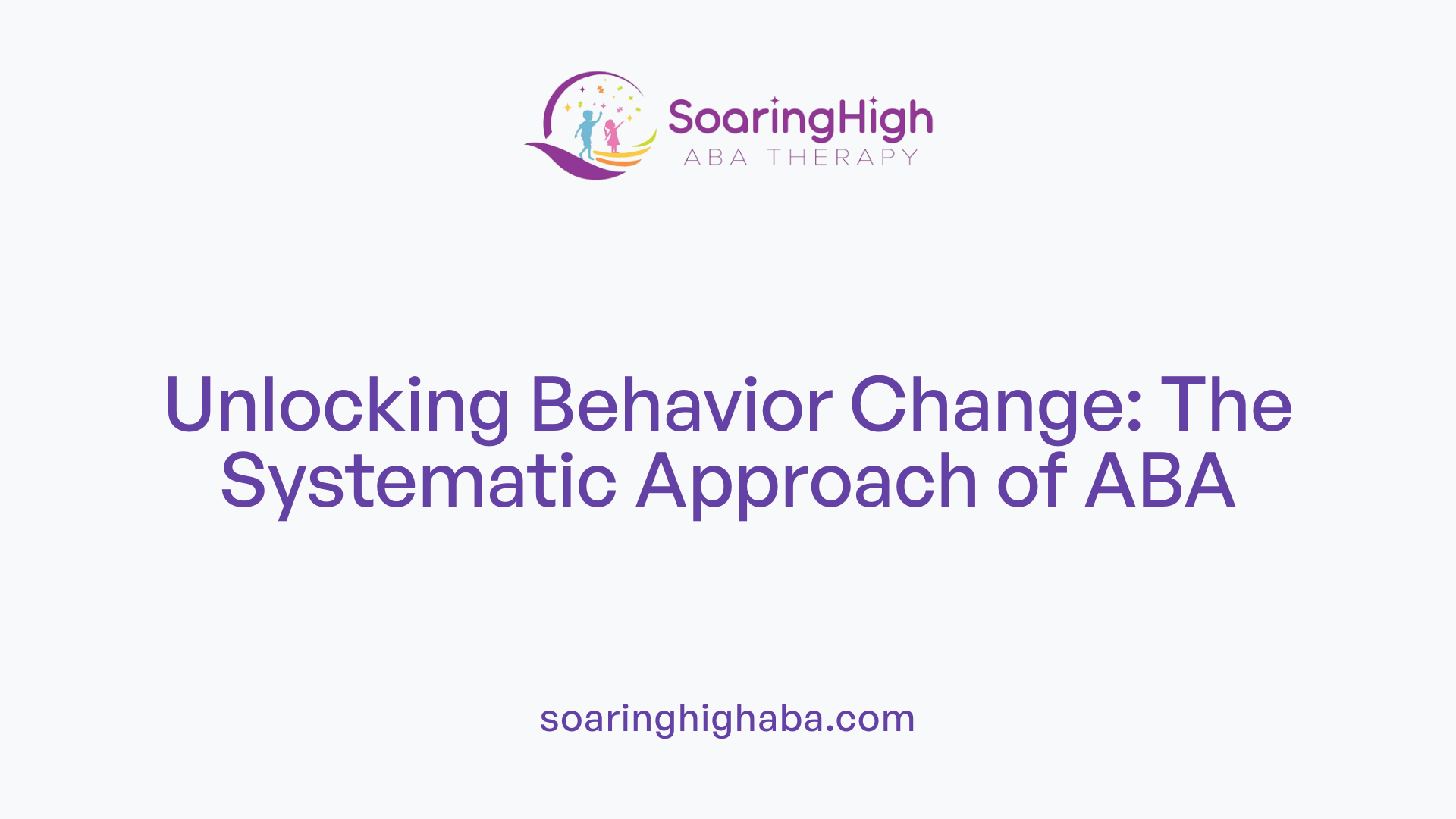Unlocking Potential with Choice-Making in ABA
Incorporating choice-making into Applied Behavior Analysis (ABA) therapy is increasingly recognized as a vital strategy to promote engagement, independence, and ethical practice. By emphasizing individuals' rights to choose, therapists can foster motivation, reduce problematic behaviors, and facilitate meaningful skill development. This article explores the benefits, principles, applications, research support, and ethical considerations related to choice-making in ABA, highlighting its importance in both clinical and educational contexts.
Understanding ABA and Its Systematic Approach
 Applied Behavior Analysis (ABA) is a scientific discipline that focuses on understanding and changing behavior through systematic methods. Its core principles include breaking down complex skills into manageable parts, using reinforcement to encourage desired behaviors, and making decisions based on data collected during interventions.
Applied Behavior Analysis (ABA) is a scientific discipline that focuses on understanding and changing behavior through systematic methods. Its core principles include breaking down complex skills into manageable parts, using reinforcement to encourage desired behaviors, and making decisions based on data collected during interventions.
ABA is highly effective because it emphasizes evidence-based practices, ensuring that interventions are tailored to individual needs and are continually monitored for progress. This approach enables practitioners to adapt strategies over time, optimizing outcomes for learners with diverse needs.
Integrating ABA techniques within educational settings offers substantial benefits. For students with autism spectrum disorder (ASD) or related disabilities, ABA provides consistent support across different parts of the school day. This consistency helps promote the generalization of learned skills, enabling students to use new abilities in various environments. Additionally, ABA fosters academic success and enhances social inclusion by encouraging participation, communication, and positive peer interactions.
A fundamental aspect of ABA therapy is the use of data-driven decision-making. Behavior analysts collect and analyze data to determine the effectiveness of interventions. This process helps identify trends, guide modifications, and ensure that each child's progress aligns with therapeutic goals.
Choice-making is a powerful strategy embedded within ABA protocols to boost active participation. It involves offering children options—such as selecting activities, reinforcers, or routines—supporting their independence and motivation. Visual supports like picture boards or activity schedules, along with verbal and physical prompts, help children understand and make choices confidently.
Implementing these strategies often begins with limited options, gradually expanding as the child gains decision-making skills. Preference assessments are conducted to identify motivating rewards, increasing the likelihood that children will engage in targeted behaviors.
Studies from 2003 to 2020 consistently demonstrate that choice-based interventions are effective across various populations and settings. For example, most experiments report positive results—92%—when using differential reinforcement with preferred options.
Choice-making can significantly reduce challenging behaviors by providing alternative avenues for escape or avoidance, ultimately increasing compliance and task completion. Within classrooms, choice boards—visual displays of options—offer structure, support decision-making, and foster independence. They serve to minimize anxiety and disruptive behaviors by giving students a sense of control.
The ethical framework guiding ABA emphasizes respecting client autonomy and promoting self-determination. Incorporating choice aligns with ethical principles such as beneficence, autonomy, and justice, while supporting culturally responsive practices.
Overall, understanding and applying ABA systematically, with a focus on choice-making, enhances the effectiveness of interventions and upholds ethical standards. It ensures that behaviors are modified in a way that respects individual preferences and promotes lasting, meaningful change.
The Role of Choice-Making in ABA Practice

What are some principles and techniques for incorporating choice-making into ABA interventions?
In ABA therapy, incorporating choices respects each individual’s preferences and promotes their autonomy. This approach makes interventions more personalized and meaningful. Techniques include offering children options during activities, like choosing between two tasks or reinforcers, which increases their engagement.
Visual supports—such as picture boards or activity schedules—are commonly used to help children understand their choices. Gradually expanding the number of options or complexity of choices helps build discrimination skills and confidence.
Strategies like experiencing the outcomes of their selections, using concurrent chains (where choices lead to different activities), and providing multiple preferred items at once, can enhance decision-making control. Embedding choices within routines and transitions encourages self-determination while reducing problem behaviors.
Consistent assessment of preferences, along with explicit teaching of decision-making skills, improves intervention outcomes. Using trauma-informed practices and positive behavioral support (PBS) principles ensures choices are respectful and supportive.
How can choice-making improve engagement and decision-making skills in individuals with autism?
Offering choices actively engages individuals with autism in their learning process. It fosters a sense of control, safety, and independence, which can reduce challenging behaviors caused by frustration or inattention.
Visual supports like pictures, icons, or symbol-based communication devices simplify decision-making for children with limited verbal skills. These supports make choices tangible and easier to understand.
When children are given opportunities to select activities, materials, or reinforcers, they develop confidence and self-esteem. This consistent practice promotes autonomous decision-making and prepares them to handle more complex choices in daily life.
Incorporating choice-making also contributes to better academic performance, social interaction, and compliance. It creates a positive, motivating environment where children feel valued and understood.
Benefits of integrating choice-making in ABA:
| Benefit | Description | Example |
|---|---|---|
| Increased engagement | Children are more active in learning activities | Choosing their preferred book or game |
| Improved motivation | Expectations become more meaningful | Selecting preferred reinforcers or activities |
| Greater independence | Builds self-reliance and decision-making skills | Picking clothes or lunch options |
| Reduced problem behaviors | Less frustration and stress from feeling in control | Avoiding tantrums by offering choices for activities |
| Enhanced communication | Encourages verbal or non-verbal exchanges during decision-making | Using picture choices to express preferences |
Overall, decision-making opportunities are essential in ABA practice. They lay the groundwork for independence, promote positive behaviors, and strengthen communication skills, leading to improved quality of life for individuals with autism.
Research Evidence Supporting Choice-Making in ABA

What does research say about the benefits of choice-making in ABA therapy?
Empirical studies from 2003 to 2020 confirm that integrating choice-making strategies into ABA therapy leads to significant improvements in various behavioral outcomes. Researchers have documented a high rate of positive results—around 92%—when using differential reinforcement techniques paired with choice options tailored to the individual’s preferences.
These studies demonstrate that providing children and clients with opportunities for choice increases engagement, motivation, and independence. Choice-making fosters a sense of control, which in turn helps reduce problem behaviors such as aggression, escape, or self-injury.
For example, preference assessments help identify the most motivating reinforcers, which are then incorporated into intervention plans to maximize learning and compliance. When children are given control over activities or rewards, they tend to participate more actively and complete tasks more consistently.
Furthermore, matching choices to the function of the behavior—such as offering avoidance options for escape-maintained behaviors or access choices for positively reinforced behaviors—improves intervention outcomes. This alignment enhances the effectiveness of behavior management and skill acquisition.
Choice-making strategies are also validated through technological adaptations like microswitches, which allow children to make selections with minimal effort, boosting compliance and independence.
Studies across diverse populations and settings show that choice-based interventions improve social interaction, reduce disruptive behavior, and increase skill generalization. When implemented thoughtfully, these approaches support not only behavioral improvement but also respect clients’ rights and preferences, aligning with ethical ABA practices.
Overall, the scientific evidence affirms that incorporating choice-making into ABA therapy is a powerful tool for promoting positive behavioral change, enhancing motivation, and supporting lifelong skills development.
Applying Choice-Making Strategies in Practice

In what ways can choice-making strategies be applied in educational and therapeutic settings?
Choice-making strategies are versatile tools used to boost engagement, independence, and motivation among individuals with different needs, especially those with autism spectrum disorder (ASD). In educational settings, teachers can embed options within daily routines, such as selecting between activities or preferred items, to foster autonomy and reduce disruptive behaviors.
Therapists often incorporate choice-making during interventions, allowing clients to select reinforcers, activities, or even the sequence of tasks. Using visual supports like picture boards, AAC devices, or activity schedules helps facilitate decision-making, especially for children with communication challenges. For example, providing a child with ASD a choice between two preferred reinforcers encourages active participation and conveys their preferences.
Applying these strategies consistently across settings ensures that individuals develop decision-making skills, leading to improved generalization of skills and enhanced self-advocacy. This approach aligns with comprehensive practices such as Positive Behavior Support (PBS) and trauma-informed care, which emphasize respect for autonomy and promoting positive behaviors.
Routine opportunities for choice help reduce anxiety, increase focus, and foster a sense of control, ultimately improving quality of life.
What are some effective methods to implement choice-making in education and therapy?
Effective implementation of choice-making involves a structured approach that ensures meaningful and manageable options for individuals. Seven practical steps can serve as a guide:
- Identify appropriate and motivating choices tailored to the individual's preferences.
- Clearly present options using visual supports like picture cards, choice boards, or digital devices.
- Offer choices before starting activities to increase engagement.
- Use prompts—verbal, gestural, or physical—to support decision-making.
- Monitor responses and gather data on preferences and effectiveness.
- Adjust options regularly to prevent boredom or frustration.
- Reinforce autonomous choices with praise or preferred rewards to strengthen decision-making skills.
Training educators and therapists to follow these steps ensures that choices remain relevant and effective. Continual assessment of individual preferences, response patterns, and outcomes helps maintain motivation and prevents overwhelm or frustration.
By using these methods, learners can improve their decision-making abilities, fostering independence and a positive learning environment. Regular evaluation and adaptation are crucial for sustained success and meaningful engagement in both educational and therapeutic contexts.
Ethical Considerations and Best Practices

What are the ethical considerations and best practices when using choice-making in ABA therapy?
When incorporating choice-making strategies into ABA therapy, it’s essential to prioritize respect for each individual’s dignity and autonomy. This means offering meaningful and appropriate options that match the person’s developmental level and personal preferences. For example, choices should be relevant, achievable, and free from coercion or undue influence.
Practitioners must be sensitive to cultural differences, ensuring that options are culturally responsive and align with the client’s values and beliefs. This helps promote engagement and respects personal backgrounds, making therapy more effective and respectful.
Close monitoring of the individual’s responses is crucial. Practitioners should watch for signs of distress, anxiety, or frustration, and adjust choices accordingly. Using visual supports like picture boards or schedules can aid understanding and facilitate successful decision-making.
Documentation is another important component. All choice opportunities, client preferences, and responses should be carefully recorded. This transparency not only supports accountability but also helps guide future interventions, ensuring they remain aligned with the client’s needs and goals.
Best practices involve systematically embedding evidence-based methods to teach and reinforce appropriate decision-making. For instance, gradually increasing the complexity of choices helps build confidence and independence.
Ultimately, the goal of ethically implementing choice-making in ABA is to empower clients by enhancing their autonomy, promoting self-determination, and respecting their control over their lives—while safeguarding their rights through ethical, professional, and culturally sensitive practices.
Integrating Human Rights and Best Ethical Practices
How does ABA therapy promote client empowerment and respect for individual preferences?
Applied Behavior Analysis (ABA) therapy emphasizes the importance of respecting each client's rights, preferences, and autonomy. By incorporating choice-making strategies, ABA allows children to actively participate in their learning processes, fostering independence and self-determination. Using visual supports like choice boards, educators and clinicians provide opportunities for children to indicate preferences, select activities, and access preferred items. This not only enhances motivation and engagement but also supports personal agency.
Choice-making opportunities serve as a form of empowerment, giving clients control over their environment and routines. When children are involved in decision-making, they develop confidence, improve communication skills, and learn self-advocacy — all vital components of respecting human rights in therapeutic settings.
What role does trauma-informed implementation play in ethical ABA practice?
Trauma-informed care recognizes that children with autism may have experienced adverse events that influence their behavior and responses. Integrating trauma awareness into ABA involves tailoring interventions to be sensitive to each child's history, avoiding practices that may inadvertently cause distress or harm.
In practice, this means creating a safe and predictable environment, using gentle prompts, and pacing the introduction of choices according to the child's comfort level. For example, presenting limited options initially and gradually expanding them helps prevent overwhelm. Visual supports and clear communication foster trust and reduce anxiety.
An ethical ABA approach values the dignity and emotional well-being of clients by respecting their boundaries and fostering a sense of safety. This trauma-informed perspective ensures that interventions are supportive, culturally responsive, and adaptable to individual needs, promoting better outcomes and upholding human rights.
How can these practices be combined to enhance ethical decision making?
Integrating client empowerment, respect for preferences, and trauma-informed strategies creates a holistic framework for ethical ABA practice. This combined approach encourages collaboration among clinicians, clients, and families, ensuring interventions are person-centered and respectful.
By continuously assessing the client's responses and preferences, and adjusting strategies accordingly, practitioners uphold ethical standards grounded in the principles of beneficence, autonomy, and justice. In doing so, ABA not only aims to produce positive behavioral outcomes but also prioritizes the client's overall well-being, dignity, and rights.
| Aspect | Focus | Implementation Example |
|---|---|---|
| Client Empowerment | Promoting independence and choice | Using decision-making activities and visual supports |
| Respecting Preferences | Honoring individual likes and dislikes | Personalizing reinforcement and activity options |
| Trauma-Informed Care | Creating a safe and supportive environment | Incorporating gradual exposure, patience, and sensory supports |
Conclusion: The Future of Choice-Making in ABA
The evolving field of Applied Behavior Analysis (ABA) continues to place a strong emphasis on empowering individuals through choice-making opportunities. Ongoing research and technological advancements are expanding our understanding of how these strategies influence engagement, independence, and overall well-being in children with autism spectrum disorder (ASD). Recent studies from 2003 to 2020 have demonstrated that incorporating choice enhances motivation, reduces problematic behaviors, and promotes skills across various settings.
As the evidence base grows, so does the importance of specialized training and professional development for practitioners. Continued education ensures that behavior analysts and educators are equipped with the latest techniques, such as effective preference assessments, visual supports, and waiting strategies, to implement choice-based interventions ethically and efficiently. This focus on competency fosters consistent, personalized, and culturally responsive practices.
Promoting a person-centered approach is vital for respecting individual preferences and promoting autonomy. Incorporating client values, social validity assessments, and cultural considerations helps tailor interventions to meet unique needs and desires. This approach supports ethical decision-making, aligns with core principles of respect and beneficence, and enhances the effectiveness of ABA therapies.
Looking ahead, future trends in ABA and choice-making strategies will likely involve integrating innovative technologies like digital choice boards and interactive platforms. These tools can provide real-time feedback, increase accessibility, and further engage learners. As research continues to inform best practices, a commitment to ongoing learning, ethical standards, and person-centered care will drive the effective implementation of choice strategies, ultimately fostering independence and enhancing quality of life for individuals with ASD.
Fostering Independence and Ethical Practice
The integration of choice-making within ABA therapy is a powerful strategy that enhances motivation, engagement, and skill development while aligning with ethical principles and human rights. As research continues to validate the effectiveness of choice-based interventions, and professionals receive ongoing training, the future of ABA is increasingly person-centered and empowering. By respecting individual preferences, promoting autonomy, and implementing trauma-informed practices, practitioners can support clients holistically—building their confidence, independence, and quality of life. Embracing choice-making as a core component of ABA not only produces better behavioral and educational outcomes but also upholds the dignity and rights of every individual served.
References
- Integrating ABA Therapy in Schools: Strategies for Success
- Choices and Preference Selection - Golden Care Therapy
- What Is Choice Theory in ABA? - ABATherapistJobs.com
- Systematic Review of Procedures and Outcomes of Choice-Based ...
- Providing Choice-Making Opportunities to Students With Autism ...
- Ethical Behavior Analysis: Evidence-Based Practice as a Framework ...
- Choice Boards and “Wait” support for students with autism in the ...





































































































